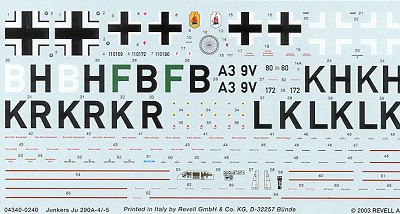
|
KIT: |
Revell AG 1/72 Ju-290A-5 |
|
KIT # |
04340 |
|
PRICE: |
$30.00 MSRP |
|
DECALS: |
options |
|
REVIEWER: |
Scott Van Aken |
|
NOTES: |

|
HISTORY |
Several of these aircraft were upgraded with more powerful engines as Ju-90S. It was then decided to build a larger and more capable anti-shipping patrol bomber using the Ju-90S data as a starting point. In 1942 production began with the first preproduction Ju-290A-0s being flown in October of that year. 5 A-1 versions were delivered in early 1943 with some A-2 variants later in the year. The A-5 was the most widely produced of the 60 Ju-290s built and was leaving the assembly lines in November of 1943. The final type, the A-7 had a glazed nose, racks for Hs-293, Hs-294 missiles as well as the Fritz X and production started in spring of 1944. Of the 25 A-7s planned, only half were built before all bomber and large aircraft programs were cancelled due the worsening war situation. Post war they type was operated briefly by the Czechs and the Spanish. One was brought to the US along with other enemy types, but I do believe it was scrapped prior to 1950.
|
THE KIT |
Though it is months late getting to the US, I'm quite glad to see it here. I also applaud Revell AG for having the guts to produce a kit like this. Not many others would have the foresight to realize that German planes of any size would be able to sell enough units to make a profit. I'm also jazzed that it is so reasonably priced. No way would any other company sell a mainstream injected kit for such a decent price. Most would ask at least twice as much if not more.
 Regardless,
we now have what I never thought I'd ever see as an injected kit in any
scale and it is huge. So much so, that I can't begin to show the sprues,
so have done the next best thing and have provided a scan of them from
the instructions. If you have built a modern Revell AG kit (and not just
something else reboxed), then you know that the quality of their new kits
is excellent. Nicely engraved panel lines, crisply molded parts and fine
decals are the norm of this and their other kits. Inspecting the parts, I
noted only a few sink areas (mostly around alignment pins), no flash and
a real effort to keep ejector pin marks out of sight.
Regardless,
we now have what I never thought I'd ever see as an injected kit in any
scale and it is huge. So much so, that I can't begin to show the sprues,
so have done the next best thing and have provided a scan of them from
the instructions. If you have built a modern Revell AG kit (and not just
something else reboxed), then you know that the quality of their new kits
is excellent. Nicely engraved panel lines, crisply molded parts and fine
decals are the norm of this and their other kits. Inspecting the parts, I
noted only a few sink areas (mostly around alignment pins), no flash and
a real effort to keep ejector pin marks out of sight.
There is a compete cockpit and cabin, much of which will be hidden from view once the kit is built. It may be that another variant is on the way as some cutting and trimming is needed during construction to get some of the parts to properly fit in place. You have the option of opening doors and hatches to allow guns to be modeled sticking out of the hatches. You can also fill in one of the upper turrets and leave the upper fuselage uncemented so that the interior can be seen. Though no display stand is provided, the kit can be built with wheels up. Perhaps this is so it can be hung from the ceiling as it will take up quite a bit of shelf space! A full radar antenna suite is also provided. While all efforts have been made to make them petite, they are a touch clunky. Huma has been able to do ultra-fine injected plastic bits so I wonder why Revell has not used that technology for this kit?
Instructions are the typical
'Euro-instructions' with no written construction guidelines and the usual
international markings. The 76 construction steps are clearly drawn and
any color information needed during construction is supplied. Colors are
referenced to Revell shades and do not correlate to any RLM shades ot her
than when the outside colors are done. Some mixing is also required.
There are markings for four aircraft, all listed as RLM 74/75 over 65.
Now I have to question the use of fighter colors on a long-range ocean
recce bird. It seems to me that the maritime colors of RLM 72/73 would
have been more appropriate, as shown by the information provided in the
reference. However, the reference does say that once the aircraft were
removed from maritime use, they were repainted in RLM 74/75 for the upper
surfaces. I think that the modeler should be aware of this and use his
judgment when it comes to camouflage. Three of the schemes are from 1./FAGr
5; 'BH' from March 1945, 'KH' from November 1944, and 'LK' from September
1944. The fourth is from 1./KG 200 in January 1944. All are identically
painted with the first plane 'BH' having heavy fuselage mottling. Decals
are printed in Italy, are matte and crisply done.
her
than when the outside colors are done. Some mixing is also required.
There are markings for four aircraft, all listed as RLM 74/75 over 65.
Now I have to question the use of fighter colors on a long-range ocean
recce bird. It seems to me that the maritime colors of RLM 72/73 would
have been more appropriate, as shown by the information provided in the
reference. However, the reference does say that once the aircraft were
removed from maritime use, they were repainted in RLM 74/75 for the upper
surfaces. I think that the modeler should be aware of this and use his
judgment when it comes to camouflage. Three of the schemes are from 1./FAGr
5; 'BH' from March 1945, 'KH' from November 1944, and 'LK' from September
1944. The fourth is from 1./KG 200 in January 1944. All are identically
painted with the first plane 'BH' having heavy fuselage mottling. Decals
are printed in Italy, are matte and crisply done.
|
CONCLUSIONS |
If you are a Luftwaffe fan, you really need to add this kit to your collection. It may be that this is the only time it will appear as large kits generally don't sell that well. I've not seen the He-177 in any other boxing nor have I seen it on the shelves since it first appeared several years ago. If you want it, buy it as it is the best modeling bang for the buck that is out there.
|
REFERENCES |
Monogram Close-up #3: Junkers Ju-290, by Thomas A Hitchcock, 1975
If you would like your product reviewed fairly and quickly by a site that has nearly 250,000 visitors a month, please contact me or see other details in the Note to Contributors.